‘There are many good reasons for buying a Carrera. The timeless shape, the powerful six-cylinder boxer engine, the way it is put together, the urge to demonstrate that you have mastered the monster, the obvious prestige value. It’s tempting. And yet, for effortless driving pleasure and near perfect roadability, take the 944 Turbo. It is the better car.‘
So read the verdict from Car magazine’s memorable comparison test of the then-new Porsche 944 Turbo against the Carrera 3.2 from its March 1985 issue – the writer, one Georg Kacher, a motoring journalist of such long-standing in Germany that he has become something of a household name in a nation that is obsessed with the automobile and the health of its home-grown automotive industry.

It’s a verdict with a number of caveats. Even in 1985, the 911 was a sports car with a near mythical status, revered by its owners, fans and motoring journos. It was also 22 years old and quirky and cranky in equal measure – then again one could argue it had the benefit of 22 years of development. Regardless, Porsche thought it could launch another 2+2 sports car, with near identical performance and a near identical price (£25,312, within £100 of the Carrera 3.2), without treading on its own toes. The company reasoned that the two cars would attract different buyers.
Good old Car blew that line of thinking out of the water. In the days before attention-seeking cover lines, Car simply put the two cars on the cover (in snow!) with the line: ‘Porsche’s 153mph 944 Turbo battles its deadliest rival.’ At the time, the magazine was the de facto number one motoring comic and didn’t need to work too hard to shift 150,000 copies a month.
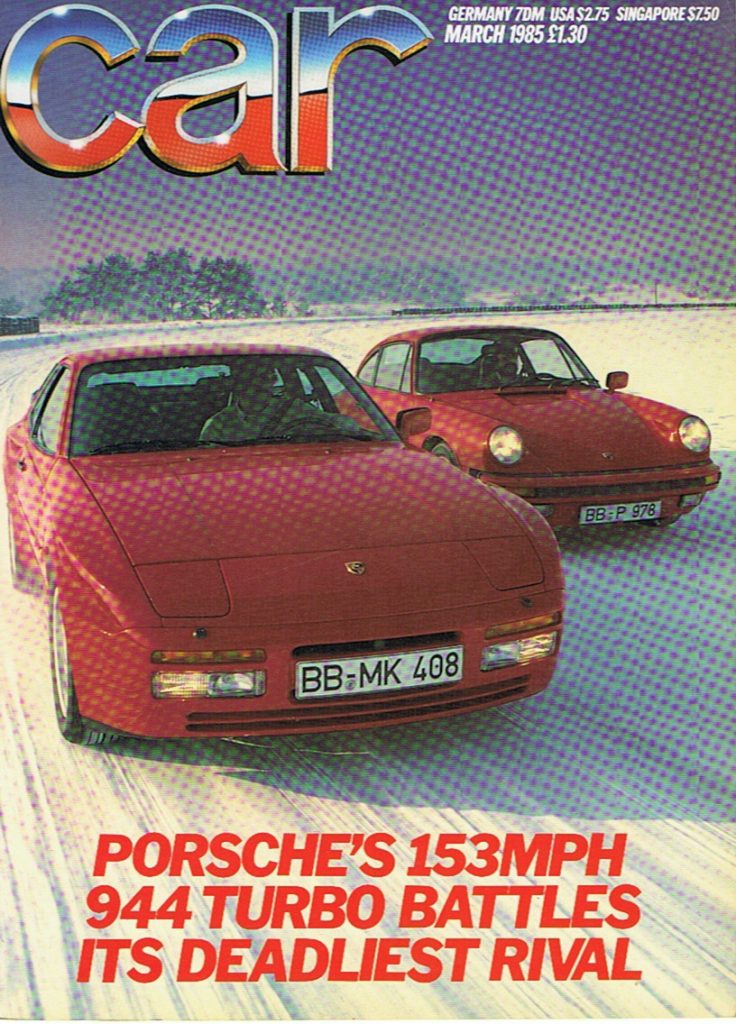
In the cold light of day, it was hard to argue with Kacher’s verdict. Taken in the context of 1985, when the 911 was getting on a bit, and really not that much different from its last major makeover in 1974, the 944 was a much more contemporary machine, for modern times. True, it was developed from the 924 – the shunned love child developed at the behest of VW, but thrown back at Porsche – but it was 95 per cent Porsche by the time the 944 Turbo arrived on the market, complete with memorable turbo script scrawled across the top of the driver’s side front wing.
If you were a Porsche virgin in the mid ’80s, but no stranger to performance cars of the era and you were in the market for a 220bhp-230bhp, £25,000 sports car – and one with a Porsche badge on the bonnet – then you could be forgiven for being somewhat perplexed after a test drive of these two. The 911’s quirks grow on you, but on first acquaintance seem positively weird. Think floor-sprouting, offset pedals, that require your foot to be lifted entirely from the footwell to work the brake and clutch, an obstructive 915 gearbox, unfathomable ventilation and frankly odd handling. In the 911 you work hard, and put up with a lot for your reward, which only comes with experience.
On the flipside the 944 Turbo is, well, normal. That is to say normal in the sense of its basic functions. Normal seating position, normal pedal location, a gearshift that flicks though the gate in a, er, normal sort of way. Sounds like we’re damning with faint praise here. We’re not. It’s just to say that compared to a 911, just about every car in 1985 could be considered ‘normal.’ Largely because their ancestry didn’t date back to a kind of VW kit car, which started off as being mid-engined, and then became rear-engined to allow a 2+2 configuration. Simplistic, perhaps, but true.
What wasn’t so ‘normal’ about the 944 Turbo was, and is, its dynamics. It had one of the first really effective turbo installations that drew on all of Porsche’s turbocharging experience, from racing and the 911 Turbo. It had handling that was – thanks to its front engine/rear transaxle layout – inspirational. Combine this with the aforementioned functionality, and you had a sports car with huge but accessible performance. For 1980s drivers in a hurry, what’s not to like?
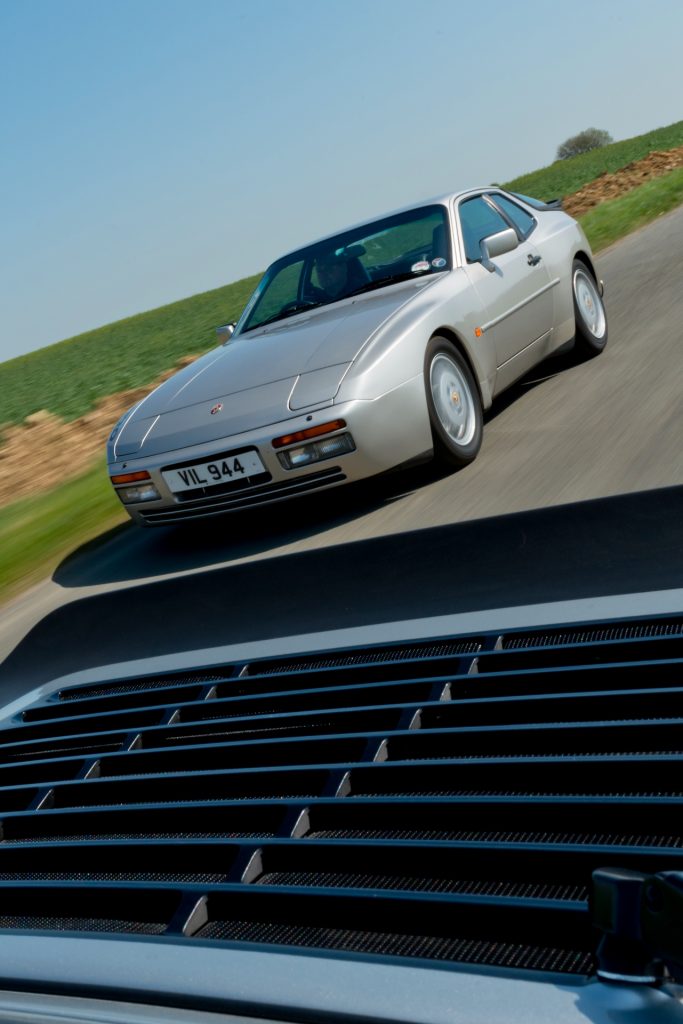
In 1985 most 911s and 944 Turbos were bought to be used as everyday transport. Most of the contemporary road tests reflected that. Kacher and Car’s test certainly did. Today the motivation for buying either car is very different.
Wind the boost forward to 2021 and one man’s main course from 1985 is now very much a light snack to be indulged in, when the mood takes. Both the modernist 944 Turbo and the already classic 911 are now in the same floating vessel. The cold, hard-edged analysis of the day-to-day no longer counts – unless, of course, you’re the sort of driver who actually prefers to ‘daily’ a car like either of these. Instead, 944 Turbo v 911 Carrera is now an emotional and aesthetic choice. It’s about how they make you feel. In which case… in which case the choice is rather more clear-cut, surely?
Well, the market certainly thinks so. Today, it separates good 944 Turbos and Carrera 3.2s by up to (and often well over) £20,000. Compare the two models using the Hagerty Price Guide for proof: the 944 Turbo S coupé fetches an average of £26,500 in condition #2, which is excellent condition, while a 911 Carrera coupé shows an average value of £50,100.
But away from price guides and on the open road, how do the two protagonists stack up after 35 years? Thanks to our friends over at Paul Stephens, the Porsche specialist, we’ve moved the game on slightly here to pitch a 1988 944 Turbo S against a 1989 Carrera 3.2. That works in both cars’ favour, since the Turbo benefits from 250bhp over the launch car’s 220bhp, a limited slip diff, plus bigger brakes and the MO30 suspension kit with Koni dampers and stiffer anti roll bars. The Carrera is one of the last of the G-Series cars and benefits accordingly from every tweak and incremental improvement, most notably the 1987 move to the G50 gearbox.
Whoever specced these two cars back in the day showed impeccable taste. The Turbo S is special order in Zermatt Silver, with a black leather interior. The Carrera is equally silver with a dark grey leather interior. Both combos make our pairing surprisingly contemporary for their age.
1988 Porsche 944 Turbo S: A rush of balanced performance
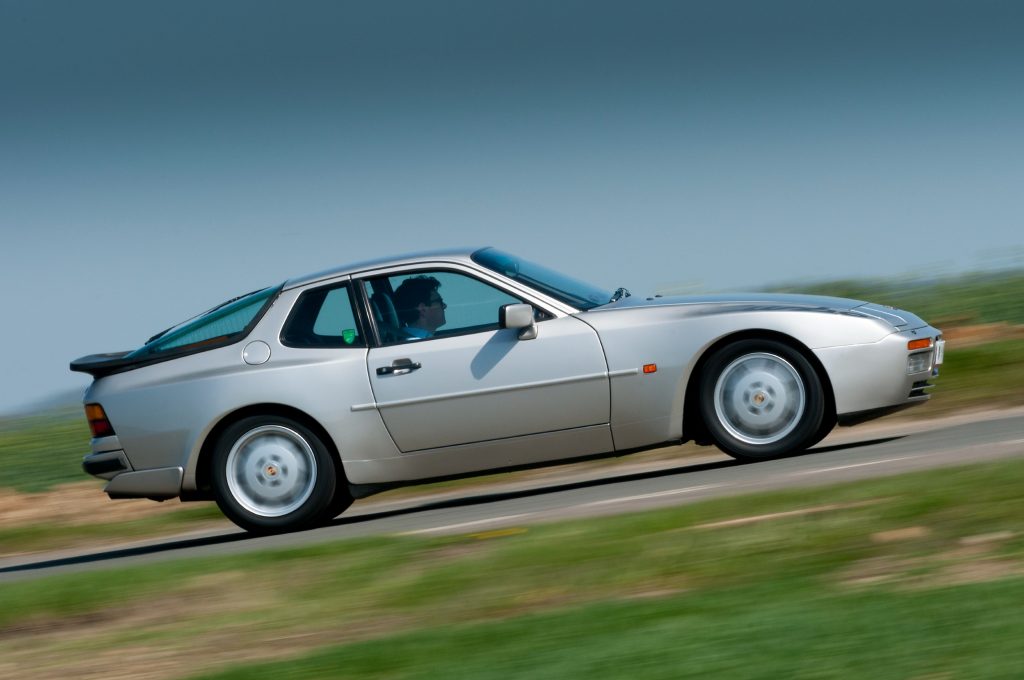
Time to go for a drive. Being a serial 944 owner I jump in the 944 Turbo S first. I should add I have also owned a Carrera 3.2 for many years, before accusations of bias are raised.
It’s a very familiar place and this car is blessed with deep bolstered ‘Sports’ seats, an option at the time of ordering, and they’re arguably the most comfortable and supportive seat that Porsche has ever produced. It’s a good start.
There are other plus points. The architecture and shapes of the dashboard and cabin furniture are unmistakably Porsche but more modern – for which you can read user-friendly. It’s simple things, such as the air vents being at the right height to blow air at your face, and the buttons looking like they belong rather than as though they were added as an afterthought.
Other details that grab your attention; The ‘BAR’ needle for the turbo’s boost pressure, sat within the rev counter. The stubby gear lever, which is as good to reach for and grasp as the 911’s is as odd to look at and waggle about its gate. There’s the reassuring familiarity of the four-spoke, H-like Porsche sports wheel, and then you get back seats and space beneath the glass tailgate that is helpful to have.
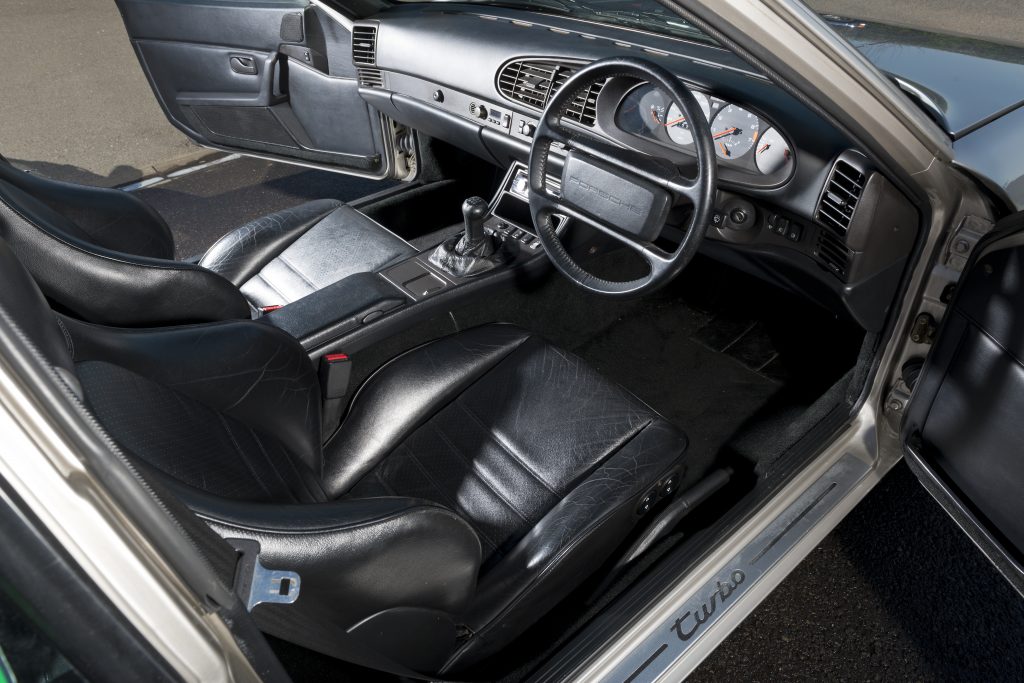
Typically, the inline-four of the Turbo churns into life. You can almost feel the strain that it takes to turn over the four big pistons. The KKK turbo acts as a suppressant, calming and quietening the engine. Air-cooled it is not.
You can tell a ropey 944 almost immediately. The big four-cylinder engine and rear transaxle are joined by a propshaft ‘torque tube’, and any wear in the engine mounts, torque tube bearings, gearbox mounts or transaxle will immediately be felt through the bodyshell. It’s a series of solutions that Porsche devised to make the 944 as smooth as possible, and far more complex than the 911’s drivetrain. Most critical are the fluid-filled engine mounts (always fit original equipment – anything else will be solid rubber), designed to smooth out the big four pot’s inherent lumpy vibe. Porsche’s engineers also used counter-rotating balance shafts to make the four-cylinder motor more appealing than it might otherwise have been.
When 944s fall into decrepitude, this is the sort of maintenance that is ignored. But not so this example. There is no bad-vibing from the drivetrain and the suspension is taut and free from unpleasant clonking sounds or shuffling antics that come with worn bushes, while the dampers still keep body control nicely in check. It is, in short, a healthy specimen, with 117,000 miles on the clock or a mere 4333 miles a year, depending on which way you want to look at it.
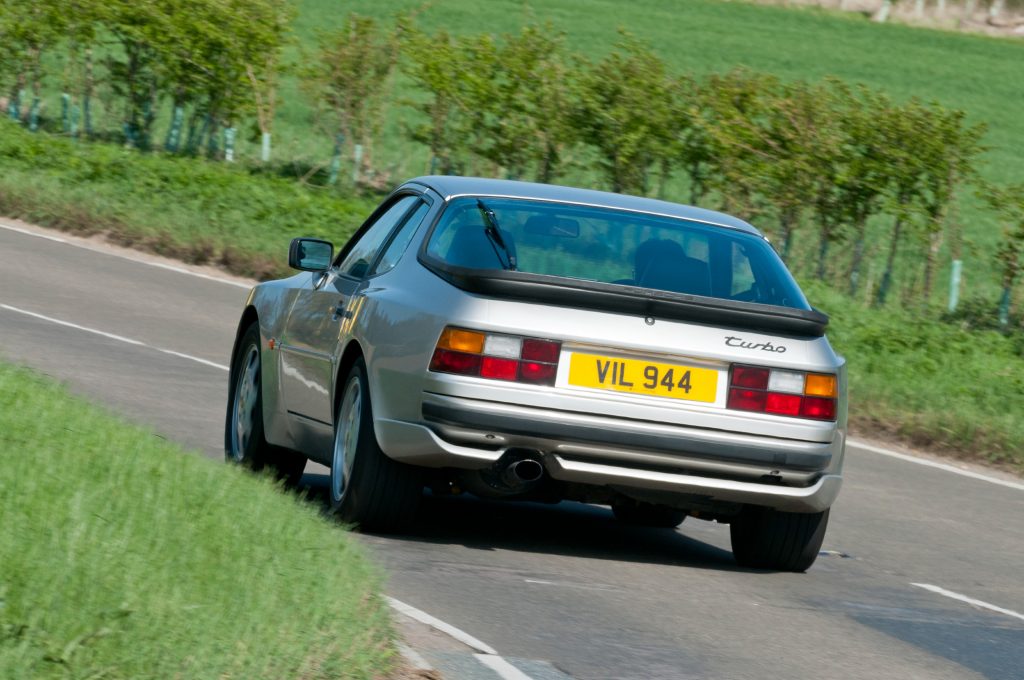
To drive the 944 Turbo S feels perfectly modern, save for a higher degree of weighting in the controls. The steering is assisted, but still has plenty of resistance and a distinct damping effect at dead centre. There is a linear feel to the clutch and a weight to the floor-mounted throttle. The gearlever is stubby, but long and pronounced in its throw. It all feels engineered and cohesive, and it also feels as though the driver environment was more closely developed around you.
It’s fast in a way only a turbocharged car can be. Boost is laggy by today’s standards, but by mid ’80s standards it’s pretty responsive, blending in smoothly from 2000rpm. Torque is rated at 258lb ft at 4000rpm, which compares with the Carrera 3.2’s 209lb ft at 4800rpm. That sort of muscle makes itself felt and the 944 Turbo does genuinely surge with a thrilling dollop of boost pressure. Rev out the engine and its power peaks at 6000rpm, giving you the choice of hovering around the middle of the rev range and using torque to do the work, or taking it by the scruff of the neck.
And the famed handling? It’s sublime. If you haven’t driven a 944, do try and bag a blast. The suspension – firm in its day – is compliant over today’s pock-marked roads and the balance is all there thanks to that 50/50, front to rear weight layout. It is the very antithesis of the pendulum-like 911, but not so benign as to be boring. Instead it flows along the road, settling into corners and powering out with a squat from the rear. When the turbo boosts it can make the motor slightly unpredictable to throttle inputs at times (in a way that a 944S2, for example, doesn’t), but overall there is a sweet harmony between the chassis and power on tap that will have you driving the 944 in complete confidence, reassured by the feel that comes through the steering and from down below.
It’s easy, then to imagine why anyone would have chosen this vision of the future over the 911, late in the ’80s. But today? Well, let’s jump into the competition and find out…
1989 Porsche 911 Carrera 3.2: The sound of music
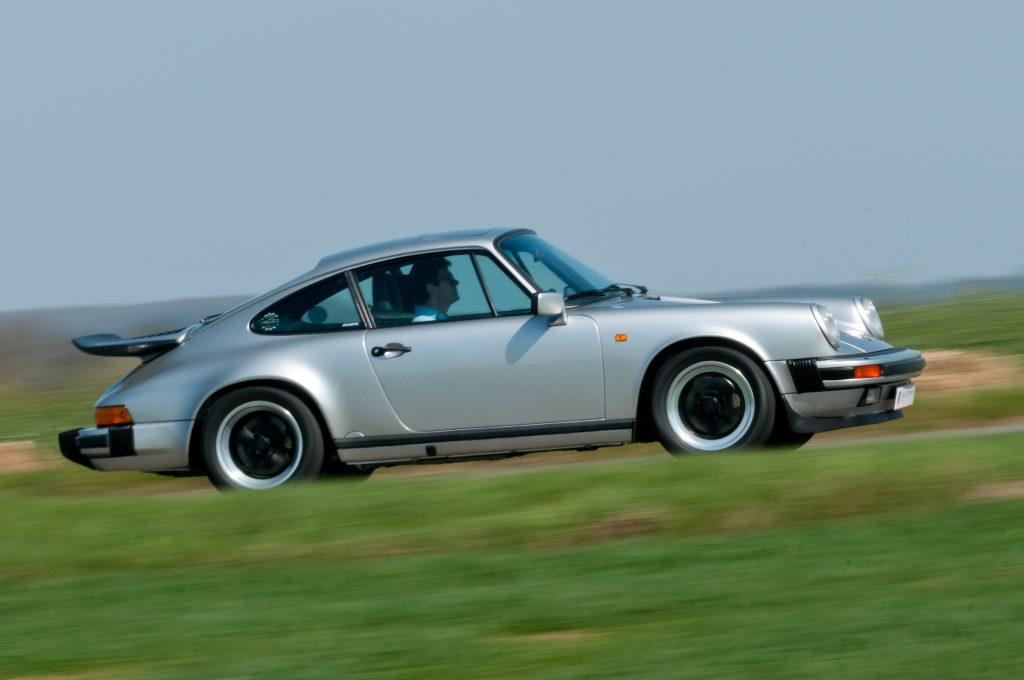
And so to the enemy within, and a car that really can wear the badge of ‘icon’ with confidence. Game over then?
No, not at all. They make for a compelling counterpoint underpinned by their contemporary rivalry. The 944 burned brightly in the ’80s; it was of its time, while the 911 has proved to be enduringly unshakeable. It doesn’t mean that it’s the better car though.
There’s no getting away from the frisson of excitement on entering a 911. Like the 944, it has the excellent, snugly-fitting ‘Sports’ option seats and the four-spoke ‘lozenge’ steering wheel, but beyond that it’s a different environment and ambience. You can sense the platform’s inherent age, because the cabin is so tight fitting and narrow, to the point that with a passenger on board you can find yourself rubbing shoulders with them.
There is no getting away, either, from the buzz that comes from starting the Carrera’s engine. Sports car manufacturers go to all sorts of lengths these days to engineer in that sense of start-up occasion – starter buttons beneath flip switches, illuminated rev counter segments, exhaust blare from cold, etc. All you need with an air-cooled 911 is a key. The rest it does for itself with a cranking, churning whine and clattering ignition underpinned by that offbeat, air-cooled thrum. There’s no shame on the 944 Turbo for not being able to compete sonically, because frankly there are not many cars that can. Noise dominates the Carrera 3.2. It is its very beguiling essence.
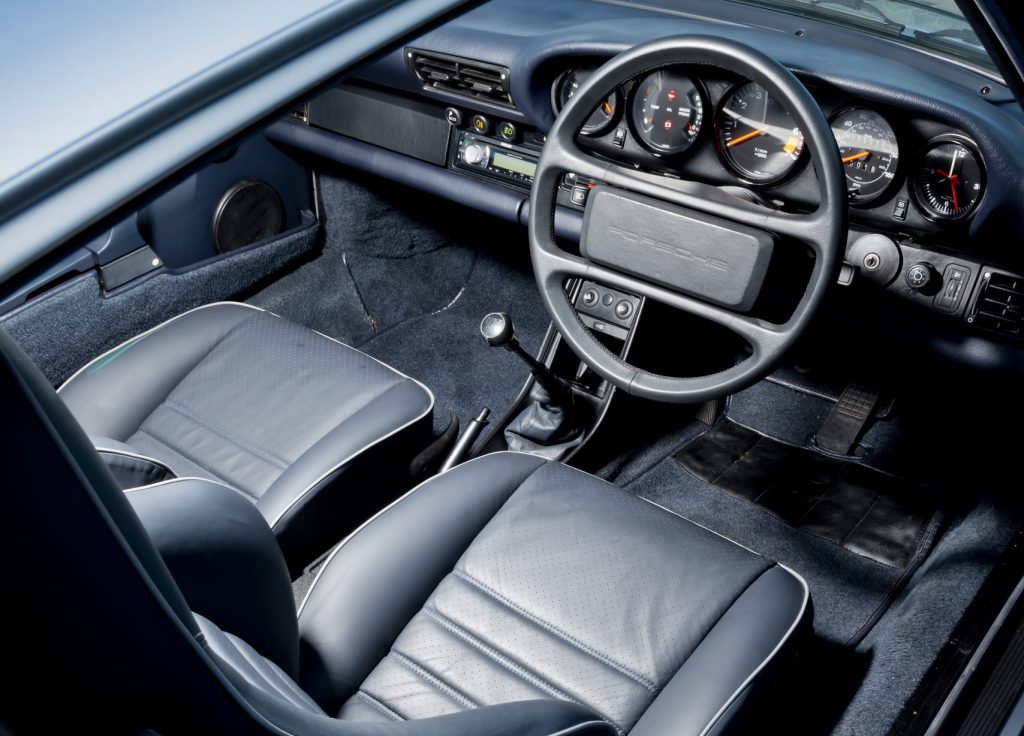
Driving it is an old school, immersive, interactive experience. It doesn’t do anything for you, although with this late version equipped with the G50 gearbox, it does at least lend a hand with changing gear. The offset pedals (left-hand drive cars are better in this respect) require a special sort of dance to operate them, while the engine responds to the long throw throttle pedal with a deep surge that starts low and peaks at a rushing, clattering, hard-edged 5900rpm, blunted slightly by the Carrera’s heavy but smoothing flywheel.
Punt it into a corner and you need to be prepared to work. There’s no power steering and with all that weight at the rear, and those big rear tyres, it doesn’t really want to know. The steering is slow-geared too, one of a raft of measures to stop the 911 from overtaking itself as weight transfer takes over from enthusiasm. It needs to be worked and bullied into a corner and once in, held there or understeer will prevail. There is, though, immense chatter and feedback though the wheel and that lovely squatting surge when the corner opens out and you can put the hammer down.
And you can use that rear engine weight to help you along. A slight lift here, an adjustment to the throttle there, and the back end can be used to assist the front. It’s part of the 911’s unique charm, and one that racers love because it gives them options. For mere mortals, though, it can be the hand that bites, rather than feeds. Put it this way, in a straight fight most mere mortals wouldn’t see which way the 944 Turbo went because it is simply the easier car to drive, devoid of the 911’s challenging traits. The 911 is a workout on wheels and on an autumn day my shirt is soaked with sweat, not helped by the 911’s – typical of the era – lack of air-conditioning.
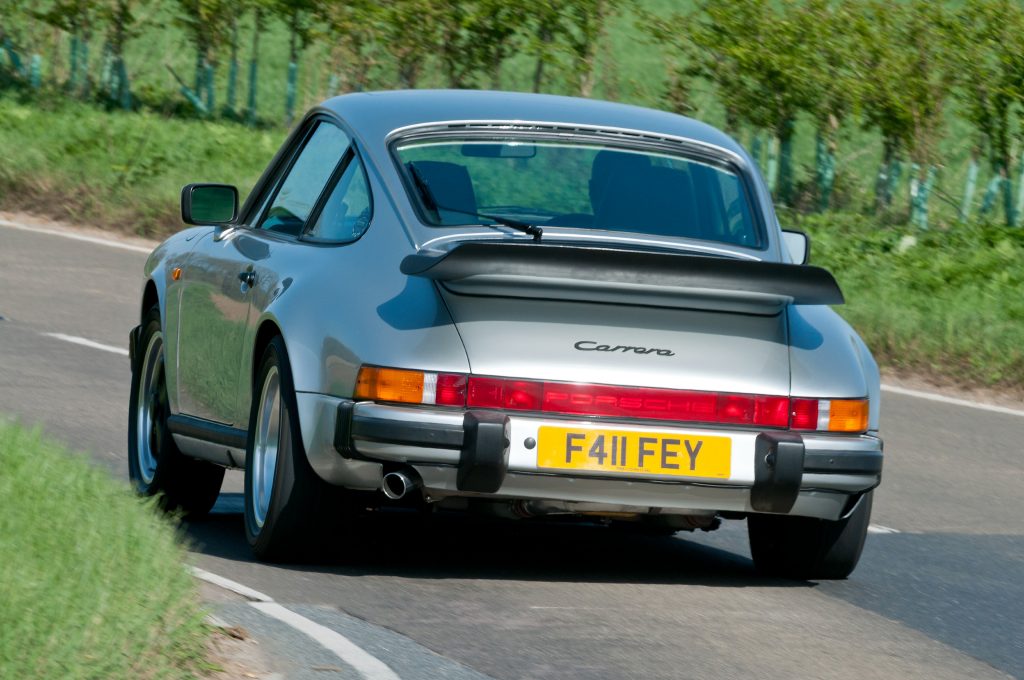
So, let’s go back again to that verdict. At the time Kacher and Car had it right. “Effortless driving pleasure, perfect roadability, the better car.” All those statements are true in the context of the time and era and they are true now. Drive each for 150 fast miles and in the 911 you will be worn out, whereas in the 944 Turbo you’ll be raring to to do it all over again. And yet? And yet the 911 has endured, prospered and flourished for all its inappropriate vices and seen off all rivals, even those from within.
It is the perfect car for a short, sharp blast and a bit of a tussle. For a purist, it is capable of rewarding in a way that the 944 Turbo can’t quite manage. The 944 Turbo misses some of the charisma, is a little bit more ‘ordinary’ but I suspect that for any person who had the use of both on a full-time basis, back in the day, it would be the 944 Turbo that came out on top as the wheels of choice.
And now? With Carrera 3.2 prices into the stratosphere, the choice for many will make itself. Good 944 Turbos are £26,500, according to the Hagerty Price Guide, which is roughly where good Carrera 3.2s were before the market accelerated like a floor-hinged throttle being mashed to the floor.
If you subscribe to the belief that their respective abilities do not equal the current price disparity, you may conclude that the 944 Turbo is where the smart money would be going right now.
Yet in the context of 2021, when daily use isn’t the overriding concern, and owning a car that will stand up the hairs on the back of your neck is, the 911 is the more thrilling choice. It’s agonising, but the 911 has to win in the context of 2021.
Fast facts: Porsche 944 Turbo S v Porsche 911 Carrera 3.2
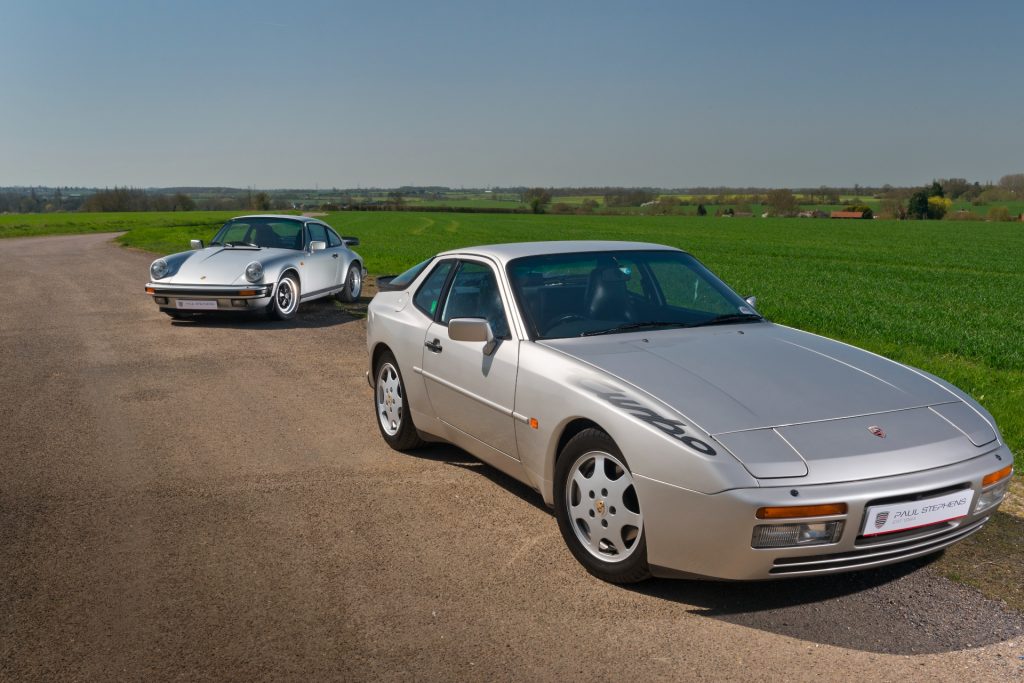
Hagerty Price Guide value: £26,500 vs £50,100
Engine: 2.5-litre inline-4-cyl turbo vs 3.2-litre flat-six-cyl
Power: 250bhp vs 231bhp
Gearbox: 5-speed manual vs 5-speed manual
Kerbweight: 1400kg vs 1210 kg
0-62mph: 5.9 secs vs 6.3 secs
Top speed: 162mph vs 149mph
Read more
Boxster at 25: Driving the car that saved Porsche
Retro Rewind: Audi RS2 vs Audi RS6
Retro Rewind: Mazda MX-5 1.8i vs MX-5 R-Sport


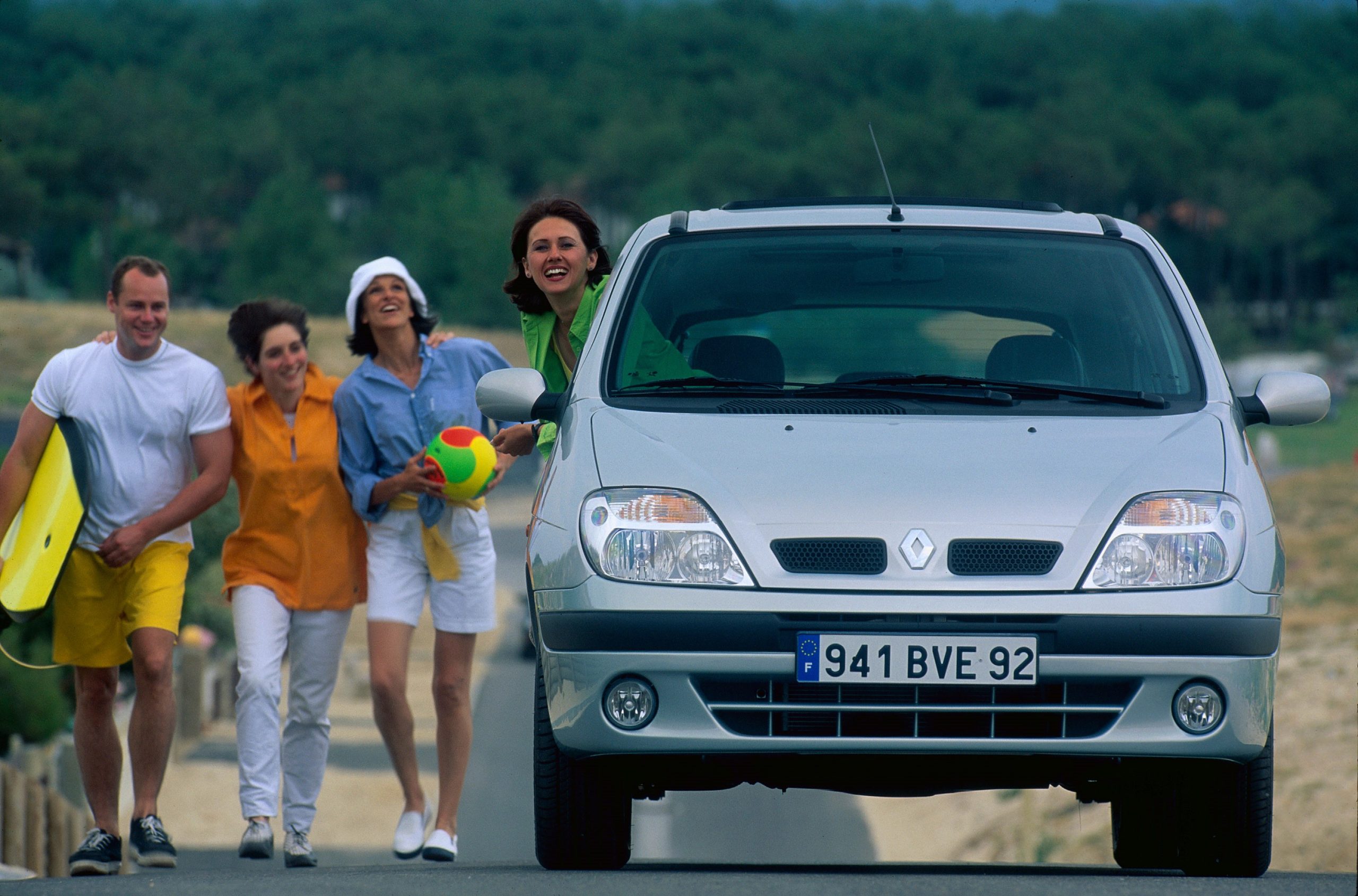
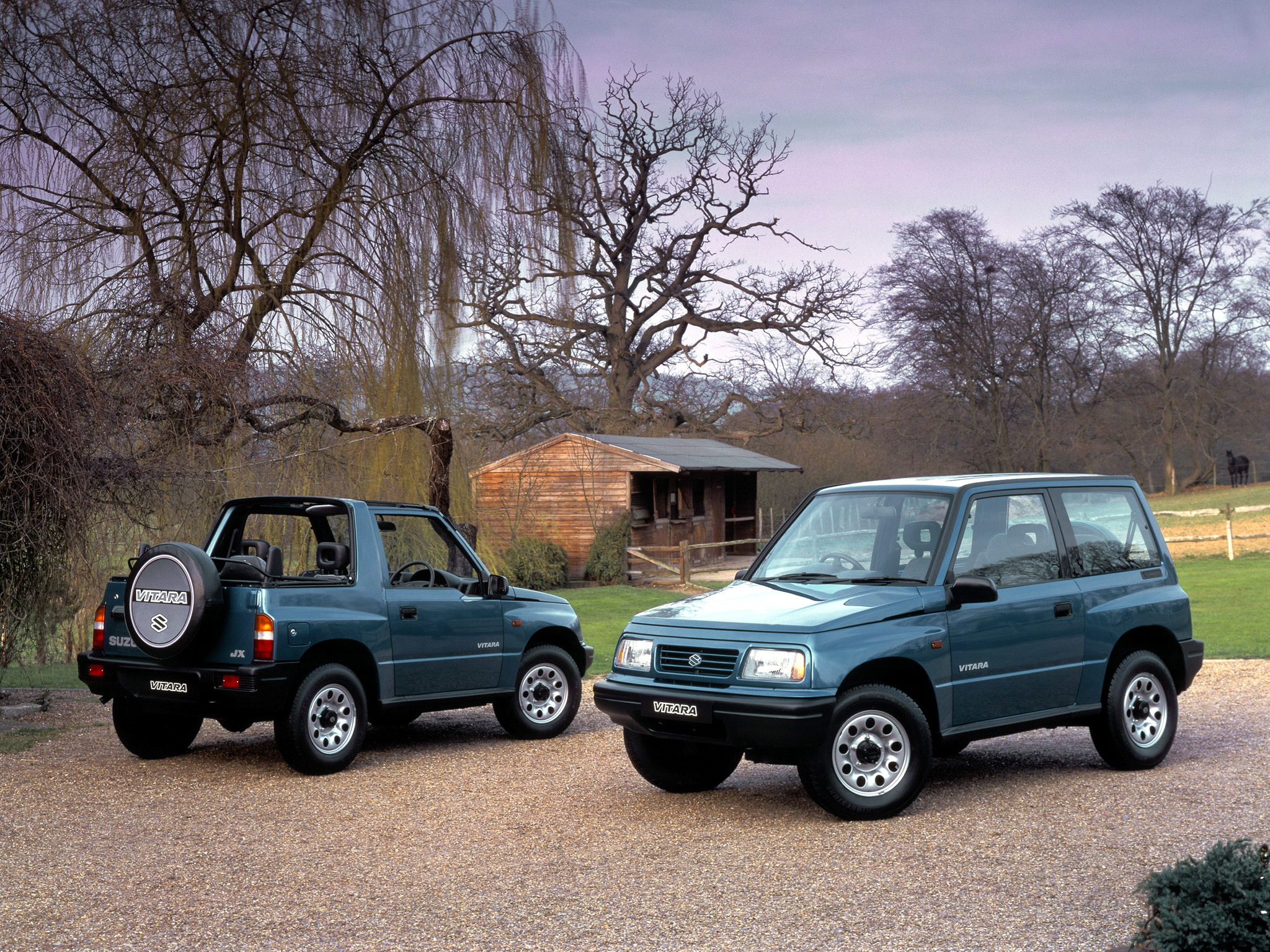
















An ECU chip on the 944 with a wastegate spring upgrade will give over 300 bhp. Now we are motoring!!!!
Excellent, subjective report, with no pulled punches! Superb.
However, wrong conclusion, in my view!
There is no comparison. The article is spot on. The 911 is a more tactile car, largely due to the engine noise and location. However the 944 turbo is a way better car on and off the racetrack. Sure, it’s not all about laptimes but get a well sorted 944 turbo (951 factory nomenclature) on a winding road with long fast sweepers and you won’t regret it. As much a sports car as a GT cruiser. Spend an extra $5-$10k on both cars and the gap gets bigger. Long live the 911. Lest we forget the 951!
I’ve owned 944’s since 1983…yes, I bought one brand new back in 1983 and I have had the pleasure of driving one for almost 50 years now. Currently, I drive a 944 Turbo with a modified suspension, exhaust system and engine management system. The turbo is so much better than a NA 944 with improved brakes, aerodynamic bits, drive train, interior (compared to an early model) and boost inducing engine the runs so hard in third gear it feels born to be on a race track…and yet, these cars always play second fiddle to the 911’s at every car show or concourse because they are not and never will be quite as “classic” as a Porsche 911. 944’s are easier to drive, less scary, more predictable – yes…but “classic vintage Porsche” with that water cooled front-mounted engine, not in most people’s minds…especially to the more casual observer who thinks “if it is not a 911, it’s not a true Porsche” most of the time. BUT LET ME ADD THIS: If I got a dollar for every time someone came up to me (especially current 911 owners) and said “I used to have a 944…I loved that car…it was so fun to drive…I really wish I had never gotten rid of it…giving that car up was a big mistake…I really miss it…you are not interested in selling yours are you?” I would be rich…this happens to me virtually ever time I take the car out…at car shows, track events, gas stations, parking lots, even when stopped waiting for trains to go by…EVERYWHERE. So it makes me wonder, if the classic 911 is really the better car, why do so may current 911 owners tell me they wish they still had their 944’s…and better yet, a 944 turbo?????
With the age of these cars it will really just come down to the example and condition. Anything made of rubber is completely shot on these cars from the 80’s by now and most of them are needing engine rebuilds. Plenty of people buy these and then when it breaks have no idea an engine rebuild cost as much as the car and a transmission rebuild is 4 mos rent. The Porsche tax is lovely, but at least parts are out there. If doing DIY, the 911 may be the better choice since it is a bit simpler and from another time.
Horses for courses, the 951 is the more accessible classic being capable of doing the business of a daily better and still be thrilling on the backroad while the 911 is the more thrilling car. But either way if it is solely about practicality there are better options same as for thrill. The thing both Porsche handle so well is to not have to compromise too much when you want practicality and thrill.
I own an ’87 Carrera and a ’90 944S2. I know it’s heresy, but for me, at least, the 944 is a better car. With the 911 I’m always watching for the car to bite me, as it switches between understeer and oversteer. I have to think about it, and that slows me down just a fraction. Maybe in another 50,000 miles it won’t. The 944 is simply more intuitive, with the CG just about the same as my own. I never have to think about the car, just the road. I probably need to sell one, and it’s not entirely an easy decsion as to which.
I raced a well prepared 951 in the SCCA for 7 seasons. In PCA2, the 2nd highest class of Porsches, we regularly got podium finishes, against much more expensive and equally prepared 911’s. “Sublime” is an understatement for the handling characteristics of a 944 turbo in good condition. In an ideal world, I would own both. Equally entertaining in their own ways.
Doug, great to hear! I refreshed my memory when driving a 944 S2 during the making of the ’21 Hagerty Bull Market, and the owner, a true enthusiast, was very generous with his car and encouraged spirited driving! A truly sweet-handling thing. Here’s a link, for reference: https://www.hagerty.co.uk/articles/market-analysis/britain-2021-bull-market-list/
Good to see all the different opinions .I will just add I took 3 years to find a 944 turbo s 1989 I had always wanted one I still have this car after 25 years been to le mans many of times just so capable very much second fiddle until you drive one on a road trip the comfort alone will please most and the mid range punch on full boost will give you that smile every time, and for that it’s a winner in my book…
Brilliant article. Just bought a 88 250bhp 944 turbo. Thread here. Excited! 😉
http://911uk.com/viewtopic.php?p=1658946#1658946
I drove one of the final 944 Turbos as my only car for 2 years. It also had the M030 option.
A brilliant car… but be under no illusion it really could bite if you pushed it hard, you had to be lightning fast to catch the resulting oversteer.